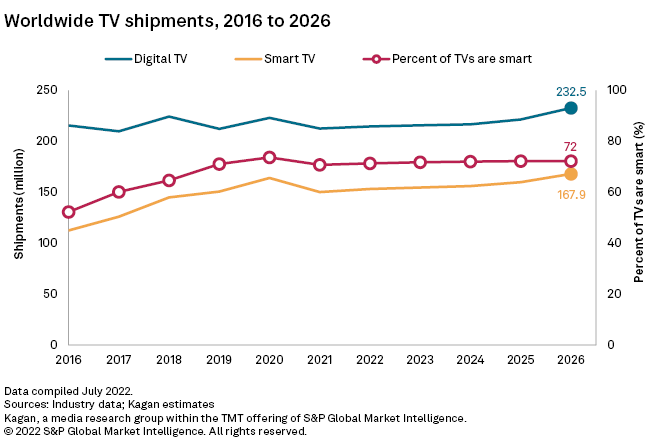Global Smart TV Shipments to See Slight 1.9% Growth in 2022
Smart TV shipments will return to better growth rates between 2023 and 2026, according to S&P’s Kagan

NEW YORK—A new report from Kagan, a media research group within S&P Global Market Intelligence, is forecasting that the global TV market is forecast to show signs of recovery in 2022 and beyond, thanks largely to improvements in the supply of large LCD panels, which was the primary obstacle manufacturers struggled with in 2021.
Meanwhile, the rapid expansion of residential broadband penetration is opening up the addressable smart TV market, driving smart TV penetration in the total TV market.
Kagan is predicting that global smart TV shipments are estimated to grow 1.9% year over year (y/y) to 153.0 million units by the end of 2022 with a forecast of 2.3% compound annual growth rate (CAGR) from 2021 to 2026.
Despite a weak first quarter for global smart TV shipments, declining panel prices and the coming World Cup in November 2022 are expected to overcome the negative effects of inflation to spark consumer demand by the end of 2022, the researchers said.
Supply shortages are still an issue for some components used in the assembly of LCD panels—especially those based on mature process technologies—but the overall supply for TV displays is slowly improving.
However, Kagan warned that the potential of a global recession, along with the continuing macroeconomic stress produced by many factors, including the conflict in Eastern Europe, could derail forecast growth.
The analysis only covers TV sets used for home entertainment, excluding commercial TV sets used in the hospitality industry as well as those used in public spaces and offices.
The professional video industry's #1 source for news, trends and product and tech information. Sign up below.
George Winslow is the senior content producer for TV Tech. He has written about the television, media and technology industries for nearly 30 years for such publications as Broadcasting & Cable, Multichannel News and TV Tech. Over the years, he has edited a number of magazines, including Multichannel News International and World Screen, and moderated panels at such major industry events as NAB and MIP TV. He has published two books and dozens of encyclopedia articles on such subjects as the media, New York City history and economics.



